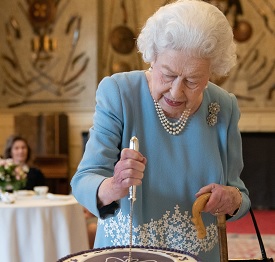
Recent reports that The Queen will only confirm her attendance at events on the day have led to questions, again, about whether she will be at the Jubilee festivities taking place in June to mark her 70 year reign. And while the idea of Her Majesty not being there might seem strange to us, a celebration led by the Royal Family while the Monarch stays at Windsor would be an exact replica of Britain’s very first royal Jubilee.
Despite their image as an eternal festivity of royal achievement, Jubilees are relatively modern. The first one didn’t take place until 1809 when Britain put on quite the party to mark the half century of the reign of George III.
The date was set for October 25th that year, as he completed 49 years as King and his reign entered its 50th year. There were several reasons for that. It chimed with the original, Biblical notion of a jubilee which comes at the end of seven cycles of seven years. And, by 1809, George wasn’t a well man. Waiting a year might mean losing the celebrations.
And that couldn’t be allowed to happen. The woman who really pushed the jubilee, Charlotte Biggs, had seen the French Revolution first hand and was terrified that the growing movement against monarchy in some parts of Europe might lead to a bloody end to Britain’s royals. Her first idea to boost the Crown had been for George III to tour his kingdom but he wasn’t well enough to go out and about. So she suggested a jubilee instead.
The whole country would celebrate their king, his reign and the monarchy on this symbolic date. George’s image would feature amidst illuminations that would light the night sky in his honour. But plans for a Service of Thanksgiving in London and for a huge banquet in the capital for the Jubilee began without any notion that the king would be there. The first Jubilee was designed around the concept of king, not his physical presence.
And that’s just how it unfolded. As preparations continued, a growing movement to include charitable events in the Jubilee helped it expand into a nationwide event. On the morning of October 25th 1809, tens of thousands of communities around Britain headed out into the streets to fete their king, some starting at dawn with choral singing from church towers that went on all day. Services took place in churches, big and small, across the country before feasts were held in every village and town, focused on providing a good meal for those most in need in honour of the king’s kindness to his country.
People wore blue ribbons to celebrate their monarch while George’s image, on ‘’transparencies’’ was placed on streets and towers. But the king himself was nowhere to be seen. He attended a private service at Windsor and went out, briefly, in a carriage on the Windsor estate. But barely anyone saw him before he headed home. His wife, Queen Charlotte, attended a huge ox roast at Windsor in his honour and hosted a fabulous celebration at Frogmore which featured a massive image of her husband. But George himself was absent in person for the whole event. The very first Jubilee was designed as a celebration of him, not with him.
As preparations for the Platinum Jubilee of his great, great, great, great granddaughter continue, it’s time to remember that this whole royal party began without anyone trying to include the star in the actual show. And think about it, what part does The Queen play in your actual Jubilee? Is she there in person? Of course not and you wouldn’t expect her to be. But she is still at the very heart of your celebrations.
There might be photos of her on the bunting, there might be pictures of her on the wall. You’ll see her on the TV and you might listen to her speak. But those photos on your bunting were taken years ago, those images on the street party posters are from that mega archive of pictures that tell the story of a 70 year reign and almost a century of royal life and service. You don’t need or expect The Queen to turn up and cut the cake for your own personal Jubilee celebrations to take place.
And as for seeing The Queen on the TV, ever changing modern technology makes that more than easy. The Jubilee Speech, now such an integral part of celebrations but introduced less than a century ago, can come live from Windsor without The Queen having to leave her seat. As could coverage of Her Majesty attending a Service of Thanksgiving at St. George’s, just as the first Jubilee Monarch did.
With social media, you’d see such celebrations before they’d even ended, images wending their way around the world. Within minutes they are the latest image of the Jubilee and that’s what you remember.
The first ever royal Jubilee unfolded without any real glimpse of the Monarch being celebrated. It turned out to be a success beyond its organisers’ wildest imaginations. Yes, we’re used to royal festivities now and they have changed and developed in the intervening years. But at their heart remains the idea of pausing to mark a moment in history and what it means for the Monarch and their country. There’s no reason to think that we can’t mark this very special milestone happening right now with a Jubilee just like the very first.

